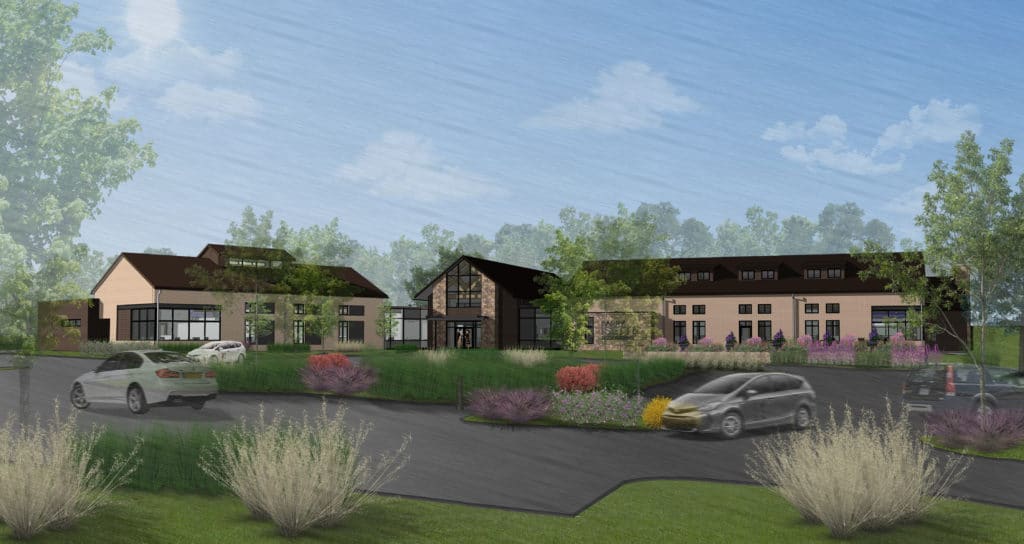St. Luke’s New Orthopedic Hospital
MKSD is proud to again partner with St. Luke’s as the architect for the latest SLUHN Orthopedic Hospital in Allentown. …
Read More > MKSD Architects
MKSD ArchitectsClient Name: Barry Isett & Associates
Project Name: Barry Isett Headquarters – Crackersport Road
Construction Completion/Opening Date: January 1, 2021
Design Team: Silvia Hoffman, Todd Chambers, John Young, Scott Focht, Justin Messere, Chris Worton, Jess Klocek
Overall SF: 20,700 SF
Construction Cost/Budget: ~$6,000,000
Barry Isett & Associates (BIA), the project client, is a multi-discipline engineering firm whose desire was to create a new headquarters building that would consolidate their office and laboratory space into one location. The project site, selected by the client, is located in South Whitehall Township on Crackersport Road in Allentown Pennsylvania. MKSD investigated various building configurations that accommodated the existing site features including sloped topography, wetlands, and a dense grouping of trees. A one-story ‘V’ shaped building was developed because it reduced site disruption and provided necessary separations of key program functions. The exterior appearance of the building was carefully designed to express the client’s company history incorporating three barn-like structures with glazed “additions” creating one interconnected structure. This exterior approach allows for the interior spaces to be divided into an office wing, a common area, and a field/lab wing. The interior of the building has an open office concept that expresses key structural and mechanical elements typically concealed in commercial construction.


Who was this project for and why?
As a company that is on the leading edge of technology in the engineering field, BIA needed an upgrade to their existing building that would better reflect their office functionality and company culture. One of the main issues hindering their existing building is that each of the seven main departments are isolated from the rest which impedes interaction between employees. This division also negatively impacts the client experience when visiting the office because instead of being able to experience the company as a whole, clients meet in conference rooms that aren’t clearly accessible to the departmental work areas. The goal for the new design was to create an office environment that promoted interaction between the employees of different departments and at the same time, better facilitated visitor contact.

Describe some of the preliminary phases of this project.
The first step in developing a program was to determine space requirements and functions for the interior of the building. MKSD interviewed Barry Isett’s department heads to get a better understanding of their current needs and how they wanted to adapt to future ones. These interviews also assisted with the development of department adjacency diagrams. Once a program was set, MKSD was able to start massing 3D forms on the site incorporating the department adjacencies into the building form. MKSD coordinated the building location and parking requirements with BIA’s civil design team.

Discuss how the project developed and some design hurdles.
One of the major design hurdles was creating an open office environment that appealed to multiple departments, each with their own needs and preferences. MKSD created an online survey that allowed all BIA employees to share their opinions on what the ideal workstation would look like. Example questions were:
After reviewing all the survey responses, MKSD developed a typical modular workstation that could be adapted to meet the needs of each department. The size and components of the modular workstation were modified throughout the design process with the assistance of virtual reality software that gave the BIA team a real-world view of their proposed office areas. The final workstation design provides flexibility, privacy, and “future-proofed” the office areas that could be adapted for future staffing needs.

What major design features were implemented?
The building has a central core with two flanking office wings, expressed visually on the outside of the building. The exterior materials and structural systems are reminiscent to barn-like construction, a nod to BIA’s company history. The central core features stone veneer and wood-look panelized fiber cement panels. Heavy timber trusses that support the central roof are visible through glass from outside the building. The office wings are composed of brick veneer with inset fiber cement panels. Steel scissor trusses supporting the office wings penetrate the exterior walls, making them an expressed element on the facades. The overall layout of the interior office space was designed to allow for each department to have their own “neighborhood”, with each neighborhood separated by storage and conference spaces. This concept allows for easy access to collaboration spaces between departments, yet still provides the necessary acoustic and visual separation required for a pleasant office environment.

MKSD is proud to again partner with St. Luke’s as the architect for the latest SLUHN Orthopedic Hospital in Allentown. …
Read More >Client Name: Embassy Bank Project Name: Embassy Bank at Liberty Street Construction Completion/Opening Date: August 2021 Design Team: Silvia Hoffman,…
Read More >The MKSD team gathered with Barry Isett and Associates on June 30th to celebrate the groundbreaking on their new headquarters…
Read More >